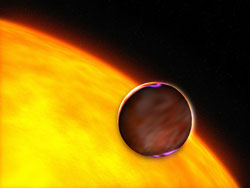An international team of astronomers has discovered an exoplanet whose orbit is steeply tilted from the plane of the star’s equator, a finding that contradicts theories about how planetary systems form.
The new observations conducted at the W. M. Keck Observatory in Hawaii provide a clear, solid measurement of the planet’s distinctive tilt, determining the angle of the orbit to be about 37 degrees from the star’s equator. The results appear in the online edition of the Astrophysical Journal and will be published in an upcoming August issue.
Astronomers discovered the planet, called XO-3b, because it passes directly in front of the star as seen from Earth – an event called a transit – thus causing a slight dimming of the star’s light. That dimming can be detected with a powerful telescope connected to a highly sensitive light meter, or photometer. Of the more than 350 exoplanets discovered so far, fewer than two dozen have been discovered through this transit method.
Detecting the planet itself was relatively easy, as it dimmed the star’s light by about one percent. But to go one step further and measure the angle of its orbit, even with such powerful tools, means that “we have to be sneaky about it,” said physicist and the paper’s lead author Joshua Winn of the Massachusetts Institute of Technology in Cambridge, Mass.
He explained that if a planet crosses the star’s disk at an angle relative to the star’s rotation, it causes a distinctive pattern that changes the overall color of the star, as measured by a highly sensitive spectrograph. In this study, astronomers John Asher Johnson of the University of Hawaii and Andrew Howard of the University of California Berkeley (UCB) used the Keck I telescope’s High Resolution Echelle Spectrometer, or HIRES, to confirm hints of such a spectral signature, which another team observed but could not verify last year.
Observing a misalignment of the planet’s orbit relative to the star’s equator is a “remarkable result,” and completely contradicts simple theories of planet formation, said astronomer and paper coauthor Geoff Marcy of UCB.
“In all models of planet formation, a young star is surrounded by a flattened disk of gas and dust, like a fried egg with the yellow yolk, the star, in the middle and the white, the gas and dust, extending outward from the equator of the ‘yolk’,” he explained.
The planets form by collecting the dust and gas together within that disk. The theories naturally explain how the planets in the Solar System reside in a flat plane that slices through the equator of the Sun. Other planetary systems show a similar architecture.
“What is shocking about this planetary system is that the planet orbits in a plane that is grossly misaligned with its star’s equator,” Marcy said.
XO-3b, is about 13 times as massive as Jupiter, yet orbits its star with a period, or “year,” of just 3.5 days. Jupiter, by contrast, takes almost 12 years to make one orbit. The planet is considered a “hot Jupiter,” meaning it resembles the Solar System’s largest planet yet is much hotter due to its proximity to its parent star.
The planet, as with all hot Jupiters, most likely didn’t form at its current orbit, but rather formed much farther out from the star, then migrated inward to its present position. Planet formation theory suggests the gravitational attraction of other planets as well as debris in the disk might tug on planets, slightly disrupting their orbit. Close encounters between or among planets, however, has enough force to significantly change the planet’s trajectory.
In the case of XO-3b, it seems “some other planet gravitationally yanked on this poor planet, jerking it out of its original circular orbit,” Marcy said. It “suffered from a gravitational close encounter. It survived, but was left in a wacky orbit.”
Astronomers are interested in exploring exoplanets, especially oddballs such as XO-3b, to help refine theories of planetary formation and to understand the kinds of variations that may be possible in the Universe. Astronomers want to “see how the dice get rolled in other planetary systems,” Winn said.
NASA’s recently launched Kepler Mission will help astronomers discover increasing numbers of exoplanets, he explained. The Keck telescopes will then be used to follow-up the space-based observations to learn more about the planets’ masses and orbits.
By discovering and observing more oddball exoplanets, astronomers will determine how often planets suffer from close encounters. And, if a large number of exoplanets are observed to have tilted orbits, scientists might be able to conclude that close encounters are common during the young lives of planets, Marcy said.
The XO-3b work was funded by the NASA Origins program, an NSF postdoctoral fellowship and World Premier International Research Center Initiative.
The W. M. Keck Observatory operates twin 10-meter optical/infrared telescopes on the summit of Mauna Kea on the island of Hawai’i. The two telescopes feature a suite of advanced instrumentation including imagers, multi-object spectrographs, high-resolution spectrographs, integral-field spectrographs and a world-leading laser-guide-star adaptive optics system. The Observatory is a scientific partnership of the California Institute of Technology, the University of California and NASA. For more information please call 808.881.3827 or visit http://www.keckobservatory.org.


